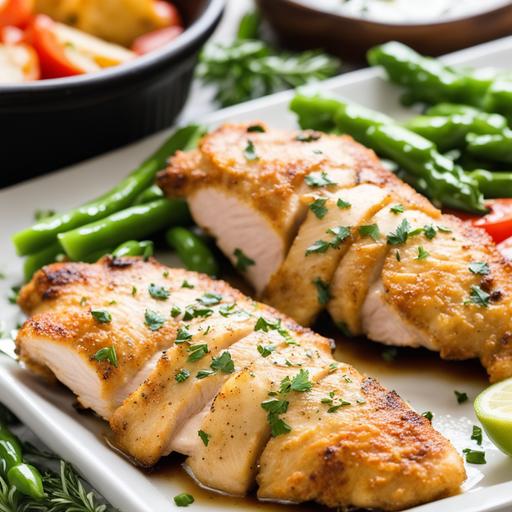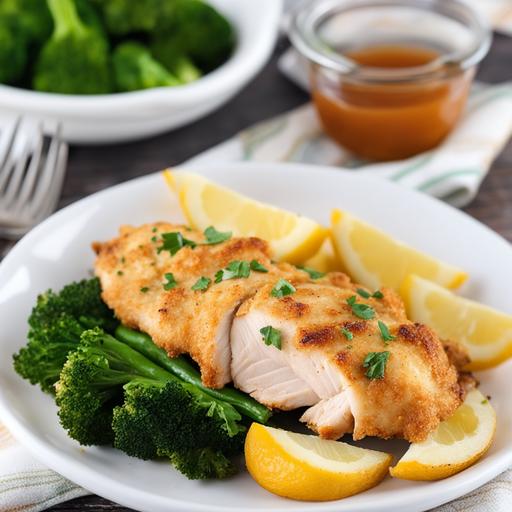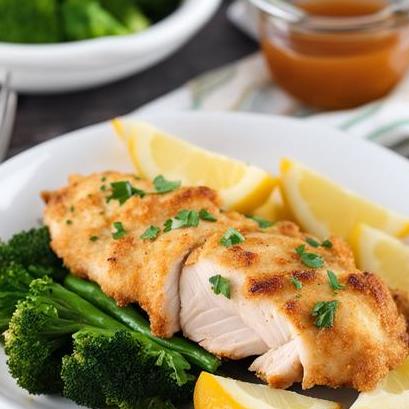
Chicken Tenderloins Oven Recipe: A Delectable And Nutritious Delight
Chicken tenderloins, known for their tender and juicy texture, are a versatile and delicious protein source. Cooking them in the oven not only provides a healthier alternative to frying but also imparts a mouthwatering flavor. This comprehensive guide will delve into the intricacies of cooking chicken tenderloins in the oven, covering an array of topics such as food science, culinary details, selection, cleaning, and preparation. Furthermore, we will explore tips, variations, doneness checks, and discuss the perils of both overcooking and undercooking. So, put on your apron and let’s get started on this delightful culinary journey!
Food Science Behind Chicken Tenderloins
Chicken tenderloins, also referred to as chicken tenders, are small cuts of meat located beneath the breast. They are often sold separately due to their unique tenderness and versatility in cooking methods. These cuts derive from the pectoralis minor muscle and have a slightly triangular shape.
The tenderness of chicken tenderloins can be attributed to the fact that they are virtually free from connective tissue. This lack of connective tissue allows for quick and even cooking, resulting in a tender and juicy texture. Additionally, tenderloins are relatively low in fat, making them a healthier choice for those watching their caloric intake.
Selecting the Perfect Chicken Tenderloins
When selecting chicken tenderloins, there are a few factors to consider to ensure optimal taste and quality. Here are some key points to keep in mind:
Freshness
Choose tenderloins that are refrigerated at or below 40°F (4°C). Ensure the packaging is intact, without any tears or leaks, to avoid potential contamination. Always check the sell-by or expiration date to ensure freshness.
Color and Appearance
Look for chicken tenderloins with a pale pink color. Avoid any pieces that have an off-putting grayish or yellowish tint, as they may indicate spoilage. The tenderloins should have a plump appearance and a slight sheen to the flesh.
Odor
Fresh chicken tenderloins should have a mild, slightly sweet smell. If you detect a sour or unpleasant odor, it is indicative of spoilage. Trust your nose and steer clear of any tenderloins with foul or pungent smells.
Cleaning and Preparation

Once you’ve selected high-quality tenderloins, it’s essential to properly clean and prepare them before cooking. Follow these steps for optimal results:
Rinsing
To remove any potential surface bacteria, rinse the chicken tenderloins gently under cold running water. Pat them dry using paper towels to ensure proper browning during cooking.
Trimming
Inspect the tenderloins and remove any visible fat or silver skin. While a minimal amount of fat adds flavor and moistness, excessive fat can lead to greasiness. Trim with a sharp knife, being careful not to remove too much meat.
Tips for Tender and Flavorful Chicken Tenderloins

To achieve the ultimate tenderness and flavor when cooking chicken tenderloins in the oven, follow these expert tips:
Marinating
Marinating the tenderloins before cooking imparts extra flavor and moisture. Create a marinade with your choice of ingredients such as citrus juices, herbs, spices, or even yogurt. Allow the tenderloins to marinate in the refrigerator for at least 30 minutes, or overnight for more intense flavor enhancement.
Seasoning
To elevate the taste profile of your oven-baked chicken tenderloins, generously season them with salt, pepper, and any desired spices. Allow the seasoned tenderloins to rest for a few minutes, ensuring the seasoning deeply penetrates the meat.
Preheating the Oven
Always preheat your oven to the recommended temperature before placing the chicken tenderloins inside. Preheating allows for even cooking and helps retain the tenderness and juiciness of the meat.
Proper Cooking Time and Temperature
Chicken tenderloins should be baked at a temperature of 400°F (205°C) to ensure thorough cooking while maintaining tenderness. The average cooking time is about 15-18 minutes, but this may vary depending on the size of the tenderloins. It is crucial to monitor the internal temperature using a meat thermometer to ensure the chicken reaches a safe minimum internal temperature of 165°F (74°C).
Recipe: Oven-Baked Chicken Tenderloins

Ingredients:
-
1 lb (450g) chicken tenderloins
-
2 tablespoons olive oil
-
1 teaspoon salt
-
1/2 teaspoon black pepper
-
1/2 teaspoon garlic powder
-
1/2 teaspoon paprika
Instructions:
-
Preheat the oven to 400°F (205°C).
-
Rinse the chicken tenderloins under cold water and pat dry with paper towels.
-
In a small bowl, mix together the salt, black pepper, garlic powder, and paprika.
-
Drizzle the olive oil over the tenderloins, then sprinkle the spice mixture evenly on both sides, ensuring each piece is well coated.
-
Place the seasoned tenderloins on a baking sheet lined with parchment paper, leaving space between them for even cooking.
-
Bake for 15-18 minutes, or until the internal temperature reaches 165°F (74°C). Ensure the chicken is cooked throughout without undercooking or overcooking.
-
Carefully remove the baking sheet from the oven, and transfer the tenderloins onto a serving platter.
-
Allow the chicken to rest for a few minutes before serving, ensuring maximum tenderness and flavor.
Adapting the Recipe: Exploring Variations

Spicy Cajun Twist
For those craving a bit of heat, substitute the paprika in the recipe with Cajun seasoning. This modification will give your chicken tenderloins a zesty kick and an intriguing flavor profile.
Mediterranean Infusion
To infuse your chicken tenderloins with Mediterranean flavors, replace the garlic powder and paprika in the recipe with a Mediterranean spice blend. Add a squeeze of lemon juice and garnish with fresh chopped parsley for a refreshing twist.
Crispy Breaded Coating
For a crunchy and satisfying texture, consider breading the chicken tenderloins before baking. Create a traditional breadcrumb mixture or experiment with ingredients such as crushed cornflakes or panko breadcrumbs. Apply an egg wash to the tenderloins and coat them thoroughly with your chosen breading before placing them in the oven.
Adding Herbaceous Notes
Amp up the aroma and fresh flavors of your chicken tenderloins by incorporating finely chopped fresh herbs into the seasoning mixture. Basil, rosemary, thyme, or a combination of these herbs will impart a delightful fragrance and add depth to your dish.
Checking Doneness: The Key to Perfect Tenderloins
To ensure your chicken tenderloins are cooked to perfection, utilize the following doneness checks:
Visual Inspection
The tenderloins should turn golden brown and have a slightly crispy exterior when fully cooked. Avoid any sections that appear undercooked or have a rubbery appearance.
Internal Temperature
Using a meat thermometer, insert it into the thickest part of a chicken tenderloin without touching bone. The internal temperature should reach a minimum of 165°F (74°C), indicating that the chicken is thoroughly cooked and safe for consumption.
Cutting Test
Cut into the thickest part of one tenderloin to assess its texture. Fully cooked chicken should be opaque throughout, with no traces of raw or pink meat.
The Perils of Overcooking and Undercooking
Both overcooking and undercooking chicken tenderloins can detract from their taste and texture. Understanding these dangers will help you avoid common pitfalls:
Overcooking
Overcooking chicken tenderloins in the oven can result in dry and tough meat. When exposed to excessive heat, the proteins in the chicken tighten, causing moisture loss. It is crucial to monitor the cooking time and internal temperature closely to prevent overcooking.
Undercooking
Consuming undercooked chicken can pose serious health risks due to potential bacteria or pathogens present in raw meat. Always ensure the internal temperature reaches the recommended minimum of 165°F (74°C) to eliminate harmful bacteria such as Salmonella or Campylobacter.
In Conclusion
Cooking chicken tenderloins in the oven is an excellent way to savor their tender and juicy qualities while maintaining a healthier cooking method. By following the steps outlined in this comprehensive guide, you can achieve perfectly cooked, flavorful, and succulent chicken tenderloins each time. Remember to embrace your creativity with seasoning and explore various adaptations to suit your preferences. So, unleash your culinary prowess, and let the inviting aroma of oven-baked chicken tenderloins fill your kitchen. Bon appétit!
Sources
FAQS On Chicken Tenderloins Oven Recipe
What’s The Best Temperature To Cook Chicken Tenderloins In The Oven?
Preheat your oven to 400°F (204°C) before placing the chicken tenderloins in it. This temperature is ideal for ensuring that they cook evenly and become golden brown on the outside and juicy on the inside.
How Long Do You Cook Chicken Tenderloins In The Oven?
The cooking time for chicken tenderloins in the oven varies depending on their size and thickness. Generally, it takes 20-25 minutes to cook chicken tenderloins in the oven. Make sure to periodically check the chicken tenderloins to avoid overcooking them.
What Kind Of Seasoning Can You Use For Chicken Tenderloins?
You can use any seasoning that you prefer for your chicken tenderloins. Popular options include garlic powder, onion powder, paprika, and dried herbs such as thyme and rosemary. You can also use a marinade or a flavorful sauce to enhance the taste of your chicken tenderloins.
Do You Need To Flip Chicken Tenderloins While Cooking Them In The Oven?
Yes, you should flip the chicken tenderloins halfway through the cooking process to ensure that they cook evenly on both sides. This helps to prevent the chicken from becoming dry or tough.
How Do You Know When Chicken Tenderloins Are Cooked Through?
You can use a meat thermometer to check if the internal temperature of the chicken tenderloins has reached 165°F (74°C), which is the minimum safe temperature recommended by the USDA. Additionally, you can cut a piece of chicken open to check if it’s no longer pink and the juices run clear.



